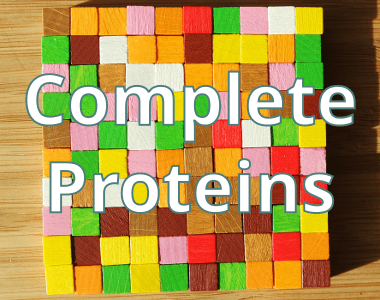Complete Proteins

Often it is stated that there are complete proteins with high quality and incomplete proteins with low quality. This primarily downgrades most plant-based foods as they lack one or more essential amino acids - limiting amino acids. Therefore, supposedly, the corresponding foods need to be combined in a meal to provide the body with all essential amino acids in sufficient amounts. However, this myth of combining proteins is also scientifically inaccurate 1 2.
Definition of complete proteins
Complete proteins, according to the definition, contain all essential amino acids for humans in sufficient quantities. In this context, plant-based representatives such as quinoa, soy, tempeh, amaranth, spirulina, buckwheat, as well as hemp seeds and chia seeds can be called complete protein sources. These foods are assigned a very high quality using biological value (outdated) and a newer calculation method, the PDCAAS.
Essential amino acid profile of a complete protein 3:
| Amino Acid | mg per g Protein |
|---|---|
| Tryptophan | 7 |
| Threonine | 27 |
| Isoleucine | 25 |
| Leucine | 55 |
| Lysine | 51 |
| Methionine + Cystine | 25 |
| Phenylalanine + Tyrosine | 47 |
| Valine | 32 |
| Histidine | 18 |
All Essential Amino Acids are Found in Plants
The definition that complete proteins are only complete if they contain adequate amounts of amino acids for humans is outdated and misleading. Because every unprocessed plant-based food contains all essential amino acids 4. From this perspective, it would be more sensible to describe these foods as valuable and high-quality protein sources.
Below are all the essential amino acids listed:
- Histidine (Foods high in histidine)
- Isoleucine (Foods high in isoleucine)
- Leucine (Foods high in leucine)
- Lysine (Foods high in lysine)
- Methionine (Foods high in methionine)
- Phenylalanine (Foods high in phenylalanine)
- Threonine (Foods high in threonine)
- Tryptophan (Foods high in tryptophan)
- Valine (Foods high in valine)
Which foods are deficient in amino acids?
Nevertheless, the concentration of amino acids in food can vary significantly from one food to another. Therefore, incomplete protein sources such as nuts, legumes, grains, fruits, or vegetables are often mentioned. For example, all amino acids are also present in apples, but in minuscule amounts. Legumes have high lysine and low methionine content, while with grains, the lysine and methionine ratios are reversed.
Amino acids are combined in the body
It is sufficient to consume all essential amino acids throughout the day through a varied vegan diet. Free amino acids are temporarily stored between meals in an amino acid pool 5. For example, if certain amino acids are missing, the body combines the previously stored free amino acids with those later added through food to form the body's own proteins (consisting of over 100 amino acids).
Conclusion
Since important nutrients, particularly micronutrients, are lost through numerous industrial processing steps, a vegan diet should be as whole and balanced as possible. Because with a balanced diet, vegans do not need to worry about complete or incomplete proteins.
 VEGANALYZE
VEGANALYZE